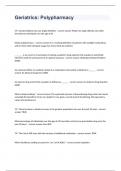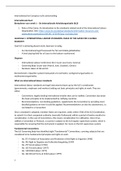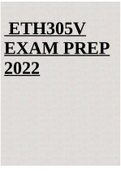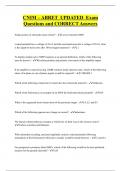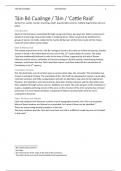Literature overview Governance & Strategy – Joyce Rommens
GOVERNANCE ............................................................................................................................................ 2
1. UNRAVELLING THE CONCEPT OF GOVERNANCE ................................................................................................ 2
Rhodes (2007) – Understanding governance: ten years on ........................................................ 3
Riley & Manias (2006) – Governance in operating room nursing: Nurses’ knowledge of
individual surgeons .................................................................................................................................. 5
Scholten et al. (2018) – Structuring ambiguity in hospital governance .................................... 6
Peters & Pierre (2001) – Developments in intergovernmental relations .................................... 7
2. WORKING WITH LAYERS ................................................................................................................................... 9
Van de Bovenkamp, Stoopendaal & Bal (2017) – Working with layers: The governance
and regulation of healthcare quality in an institutionally layered system ............................... 9
Stoopendaal & van de Bovenkamp (2015) – The mutual shaping of governance and
regulation of quality and safety in Dutch healthcare ................................................................. 10
3. DECENTRALISATION OF CARE ......................................................................................................................... 11
Lowndes & Sullivan (2008) – How low can you go? Rationales and challenges for
neighborhood governance ................................................................................................................ 11
Saltman & Bankauskaite (2006) – Conceptualizing decentralisation in European health
systems: A functional perspective ..................................................................................................... 13
Singleton (2005) – The promise of public health: vulnerable policy and lazy citizens ........ 16
Bochove et al. (2016) – Reconstructing the professional domain: boundary work of
professionals and volunteers in the context of social service reform ...................................... 17
STRATEGY ................................................................................................................................................... 19
1. UNRAVELLING THE CONCEPT OF STRATEGY ..................................................................................................... 19
Mintzberg (1990) – The design school: reconsidering the basic premises of strategic
management .......................................................................................................................................... 19
Jarzabowski et al. (2007) - Strategizing: the challenges of a practice perspective............ 21
Wijngaarden et al. (2010) – Strategic analysis for health care organisations: suitability of
the SWOT analysis................................................................................................................................... 23
De Korne et al. (2012) – Hospital benchmarking: are U.S. eye hospitals ready?.................. 25
Spee & Jarzabowski (2009) – Strategy tools as boundary objects ........................................... 26
2. STRATEGY DEVELOPMENT/WORKING WITH STRATEGY ...................................................................................... 28
Johnson et al. (2007) – Chapter 7: Business strategy and models ............................................ 28
Scholes (1998) – Chapter 10: Stakeholder mapping: a practical tool for managers ......... 30
Johnson et al. (2010) – The ritualization of strategy workshops ................................................. 30
1
, Literature overview Governance & Strategy – Joyce Rommens
Governance
1. Unravelling the concept of governance
Targets:
- Describe contemporary challenges in healthcare governance
- Explain how the (national) institutional context matters for goals and challenges in
healthcare governance and strategy
- Provide a description of the concept of governance
- Explain the concept of networks in governance theory
- Explain that governance can be studied at different levels (micro, meso, macro), using
different theoretical lenses
Literature overview:
- Rhodes (2007) – Understanding governance: ten years on
- Riley & Manias (2006) – Governance in operating room nursing: Nurses’ knowledge of
individual surgeons
- Scholten et al. (2018) – Structuring ambiguity in hospital governance
- Peters & Pierre (2001) – Developments in intergovernmental relations
Governance is about a movement from government decisions to more local decision-making
processes.
2
, Literature overview Governance & Strategy – Joyce Rommens
Rhodes (2007) – Understanding governance: ten years on
How is governance defined and described?
A new process of governing; or a changed condition or ordered rule; or the new method by which
society is governed. However, nothing in the social sciences is ever that simple. Therefore,
governance wearing public administrations and public policy spectacles is defined as:
1. Interdependence between organisations. Governance is broader than government,
covering non-state actors. Changing the boundaries of the state, meant the boundaries
between public, private and voluntary sectors became shifting and opaque.
2. Continuing interactions between network members, caused by the need to exchange
resources and negotiate shaped purposes
3. Game-like interactions, rooted in trust and regulated by rules of the game negotiated and
agreed by network participants.
4. A significant degree of autonomy from the state. Networks are not accountable to the
state; they are self-organising. Although the state does not occupy a privileged, sovereign
position, it can indirectly and imperfectly steer networks.
Governance refers to governing with and between members in networks. Governing with and
through networks.
Main concepts: network governance, hollowing out.
Level: macro. Author’s focus on macro, but also points at micro-level practices to explore how
governance plays out in daily practices.
Rhodes approach forms the basis for a multi-level understanding (covering micro/meso/macro). The
key here is networks.
- “Many unclear separations of public and private powers.” (p. 1257)
- “Governance refers to governing with and through networks.” (p. 1246)
- “This approach focuses on beliefs and ideas, on the games people play, and on the role of
both in explaining how the practices of network governance change.” (p. 1252)
What is the role of governance: what or whom is being ‘steered’ and how? What does this tell us
about what the concept of governance entails?
Governance is interaction and interdependence between members. It explores the limits to the state
and seeks to develop a more diverse view of state authority and its exercise.
3
, Literature overview Governance & Strategy – Joyce Rommens
The ‘hollowing out of the state’ means simply that the growth of governance reduced the ability of
the core executive to act effectively, making it less reliant on a command operating code and more
reliant on diplomacy.
® The state is not completely broken up, can still change the rules of the game, but central
government model requires correction.
It is becoming more and more difficult to do everything from one power, so more and more power is
shared. So, the responsibility that used to lie entirely with the government is increasingly being
distributed. But government remains dominant, so hollow out is not static, but mobile: shadow of
hierarchy: state still has power, but in a different form, through negotiations and networks. The state
then makes the rules (rules of the game), so that the government makes the frameworks
(legislation). So, there is decentralisation, but state has leading role (shadow).
Core executive: “which functions define the innermost part or heart of British government? The core
functions of the British executive are to pull together and integrate central government policies and
to act as final arbiters of conflicts between different elements of the government machine. These
functions can be carries out by institutions other than prime minister and cabinet, for example, the
treasury and the cabinet office.
® Power lies within the relationships between different positions, not within specific positions
Organizations B and C have an influence on the decision-making processes of organization A. The
dominant coalition has discretion and employs strategies to regulate the process of exchange.
- Corporate management and marketization ® fragmentation; pressure to cooperate.
Networks are characterized by trust and diplomacy.
- With the spread of networks there has been a recurrent tension between contracts (stress
on competition ® best prices) and networks (stress on cooperative behaviour).
- Trust is essential for cooperative behaviour – networks are high on trust and
contracts low on trust
Network governance has two faces: (1) public sector change (can be increased fragmentation and
joined-up governance) and (2) interprets British government; the hierarchic model of responsible
government is no longer acceptable.
Discussion:
® Policy networks pay little attention to change and the role of ideas in change. The danger is that
identifying categories of exogenous change (economic, ideological, knowledge and institutional)
implies that change is independent of the policy network. Yet, actors in the network shape and
construct their world (choosing how to respond).
® There is a persistent asymmetry between a constitutional superior (central government) and a
constitutional subordinate (local government) because the centre can unilaterally change the rules of
the game.
4
GOVERNANCE ............................................................................................................................................ 2
1. UNRAVELLING THE CONCEPT OF GOVERNANCE ................................................................................................ 2
Rhodes (2007) – Understanding governance: ten years on ........................................................ 3
Riley & Manias (2006) – Governance in operating room nursing: Nurses’ knowledge of
individual surgeons .................................................................................................................................. 5
Scholten et al. (2018) – Structuring ambiguity in hospital governance .................................... 6
Peters & Pierre (2001) – Developments in intergovernmental relations .................................... 7
2. WORKING WITH LAYERS ................................................................................................................................... 9
Van de Bovenkamp, Stoopendaal & Bal (2017) – Working with layers: The governance
and regulation of healthcare quality in an institutionally layered system ............................... 9
Stoopendaal & van de Bovenkamp (2015) – The mutual shaping of governance and
regulation of quality and safety in Dutch healthcare ................................................................. 10
3. DECENTRALISATION OF CARE ......................................................................................................................... 11
Lowndes & Sullivan (2008) – How low can you go? Rationales and challenges for
neighborhood governance ................................................................................................................ 11
Saltman & Bankauskaite (2006) – Conceptualizing decentralisation in European health
systems: A functional perspective ..................................................................................................... 13
Singleton (2005) – The promise of public health: vulnerable policy and lazy citizens ........ 16
Bochove et al. (2016) – Reconstructing the professional domain: boundary work of
professionals and volunteers in the context of social service reform ...................................... 17
STRATEGY ................................................................................................................................................... 19
1. UNRAVELLING THE CONCEPT OF STRATEGY ..................................................................................................... 19
Mintzberg (1990) – The design school: reconsidering the basic premises of strategic
management .......................................................................................................................................... 19
Jarzabowski et al. (2007) - Strategizing: the challenges of a practice perspective............ 21
Wijngaarden et al. (2010) – Strategic analysis for health care organisations: suitability of
the SWOT analysis................................................................................................................................... 23
De Korne et al. (2012) – Hospital benchmarking: are U.S. eye hospitals ready?.................. 25
Spee & Jarzabowski (2009) – Strategy tools as boundary objects ........................................... 26
2. STRATEGY DEVELOPMENT/WORKING WITH STRATEGY ...................................................................................... 28
Johnson et al. (2007) – Chapter 7: Business strategy and models ............................................ 28
Scholes (1998) – Chapter 10: Stakeholder mapping: a practical tool for managers ......... 30
Johnson et al. (2010) – The ritualization of strategy workshops ................................................. 30
1
, Literature overview Governance & Strategy – Joyce Rommens
Governance
1. Unravelling the concept of governance
Targets:
- Describe contemporary challenges in healthcare governance
- Explain how the (national) institutional context matters for goals and challenges in
healthcare governance and strategy
- Provide a description of the concept of governance
- Explain the concept of networks in governance theory
- Explain that governance can be studied at different levels (micro, meso, macro), using
different theoretical lenses
Literature overview:
- Rhodes (2007) – Understanding governance: ten years on
- Riley & Manias (2006) – Governance in operating room nursing: Nurses’ knowledge of
individual surgeons
- Scholten et al. (2018) – Structuring ambiguity in hospital governance
- Peters & Pierre (2001) – Developments in intergovernmental relations
Governance is about a movement from government decisions to more local decision-making
processes.
2
, Literature overview Governance & Strategy – Joyce Rommens
Rhodes (2007) – Understanding governance: ten years on
How is governance defined and described?
A new process of governing; or a changed condition or ordered rule; or the new method by which
society is governed. However, nothing in the social sciences is ever that simple. Therefore,
governance wearing public administrations and public policy spectacles is defined as:
1. Interdependence between organisations. Governance is broader than government,
covering non-state actors. Changing the boundaries of the state, meant the boundaries
between public, private and voluntary sectors became shifting and opaque.
2. Continuing interactions between network members, caused by the need to exchange
resources and negotiate shaped purposes
3. Game-like interactions, rooted in trust and regulated by rules of the game negotiated and
agreed by network participants.
4. A significant degree of autonomy from the state. Networks are not accountable to the
state; they are self-organising. Although the state does not occupy a privileged, sovereign
position, it can indirectly and imperfectly steer networks.
Governance refers to governing with and between members in networks. Governing with and
through networks.
Main concepts: network governance, hollowing out.
Level: macro. Author’s focus on macro, but also points at micro-level practices to explore how
governance plays out in daily practices.
Rhodes approach forms the basis for a multi-level understanding (covering micro/meso/macro). The
key here is networks.
- “Many unclear separations of public and private powers.” (p. 1257)
- “Governance refers to governing with and through networks.” (p. 1246)
- “This approach focuses on beliefs and ideas, on the games people play, and on the role of
both in explaining how the practices of network governance change.” (p. 1252)
What is the role of governance: what or whom is being ‘steered’ and how? What does this tell us
about what the concept of governance entails?
Governance is interaction and interdependence between members. It explores the limits to the state
and seeks to develop a more diverse view of state authority and its exercise.
3
, Literature overview Governance & Strategy – Joyce Rommens
The ‘hollowing out of the state’ means simply that the growth of governance reduced the ability of
the core executive to act effectively, making it less reliant on a command operating code and more
reliant on diplomacy.
® The state is not completely broken up, can still change the rules of the game, but central
government model requires correction.
It is becoming more and more difficult to do everything from one power, so more and more power is
shared. So, the responsibility that used to lie entirely with the government is increasingly being
distributed. But government remains dominant, so hollow out is not static, but mobile: shadow of
hierarchy: state still has power, but in a different form, through negotiations and networks. The state
then makes the rules (rules of the game), so that the government makes the frameworks
(legislation). So, there is decentralisation, but state has leading role (shadow).
Core executive: “which functions define the innermost part or heart of British government? The core
functions of the British executive are to pull together and integrate central government policies and
to act as final arbiters of conflicts between different elements of the government machine. These
functions can be carries out by institutions other than prime minister and cabinet, for example, the
treasury and the cabinet office.
® Power lies within the relationships between different positions, not within specific positions
Organizations B and C have an influence on the decision-making processes of organization A. The
dominant coalition has discretion and employs strategies to regulate the process of exchange.
- Corporate management and marketization ® fragmentation; pressure to cooperate.
Networks are characterized by trust and diplomacy.
- With the spread of networks there has been a recurrent tension between contracts (stress
on competition ® best prices) and networks (stress on cooperative behaviour).
- Trust is essential for cooperative behaviour – networks are high on trust and
contracts low on trust
Network governance has two faces: (1) public sector change (can be increased fragmentation and
joined-up governance) and (2) interprets British government; the hierarchic model of responsible
government is no longer acceptable.
Discussion:
® Policy networks pay little attention to change and the role of ideas in change. The danger is that
identifying categories of exogenous change (economic, ideological, knowledge and institutional)
implies that change is independent of the policy network. Yet, actors in the network shape and
construct their world (choosing how to respond).
® There is a persistent asymmetry between a constitutional superior (central government) and a
constitutional subordinate (local government) because the centre can unilaterally change the rules of
the game.
4

